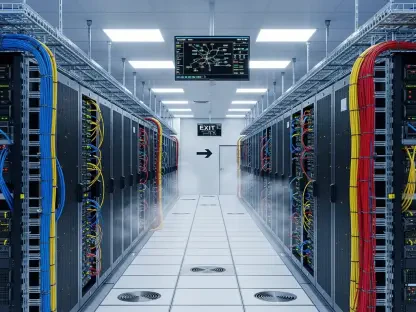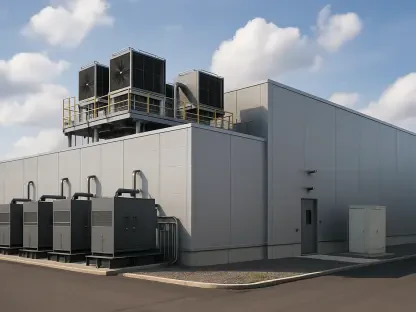Setting the Stage for AI Hardware Evolution
In a landscape where artificial intelligence drives unprecedented computational demands, Nvidia stands at the forefront with its Rubin CPX GPU, a specialized solution targeting the complexities of long-context AI inference. Consider this: modern large language models (LLMs) now process up to 10 million tokens in a single context window, a staggering leap from just a few thousand tokens a few years ago. This exponential growth underscores a critical challenge for businesses and tech providers—how to manage skyrocketing memory and power needs without sacrificing efficiency or breaking budgets. The Rubin CPX emerges as a pivotal response to these pressures, promising to reshape the market for AI hardware.
This analysis dives deep into the significance of Nvidia’s latest offering, examining its role within the broader AI inference ecosystem. It explores current market trends, competitive dynamics, and the technological advancements that position this GPU as a potential game-changer. By unpacking data, projections, and industry shifts, the goal is to provide stakeholders with actionable insights into how specialized hardware can address the escalating needs of AI workloads. The focus extends beyond a single product to the broader implications for infrastructure scalability and cost management in a rapidly evolving sector.
Market Trends and In-Depth Analysis of AI Inference
Surge in Context Window Demands
The AI market is witnessing a transformative shift as context windows—the amount of data a model can process simultaneously—expand at an extraordinary pace. Current benchmarks show models handling millions of tokens, driven by applications like code generation and advanced chatbots that require deep data comprehension. This trend places immense pressure on traditional GPU architectures, which struggle to balance the compute-heavy prefill phase and memory-intensive decode phase of inference. As a result, inefficiencies in resource allocation have become a bottleneck, pushing the industry toward innovative solutions.
Market data indicates that the demand for long-context processing is not a niche concern but a core driver of AI adoption across sectors like software development and customer service automation. Projections suggest that by 2027, over 60% of enterprise AI deployments will rely on models with context windows exceeding 100,000 tokens. This growth fuels a pressing need for hardware tailored to specific inference stages, a gap that Nvidia aims to address with its Rubin CPX. The market’s trajectory points to a future where generalized hardware becomes obsolete, replaced by modular, task-specific designs.
Nvidia’s Strategic Positioning with Rubin CPX
Nvidia’s Rubin CPX GPU enters the market as a specialized tool for the prefill phase of long-context AI inference, leveraging cost-effective GDDR7 memory to deliver 30 petaFLOPS of NVFP4 compute performance with 128 GB capacity. Unlike high-bandwidth memory (HBM) solutions, which are power-hungry and expensive, GDDR7 prioritizes energy efficiency, aligning with the growing industry emphasis on sustainable computing. By pairing Rubin CPX with HBM-equipped GPUs for the decode phase, Nvidia optimizes resource allocation, a move that could reduce operational costs by up to 30% for large-scale AI deployments, based on early performance claims.
The introduction of disaggregated serving, exemplified by Nvidia’s Vera Rubin NVL144 CPX rack-scale systems, further solidifies its market edge. These systems, featuring a mix of 16 GPUs per compute tray, demonstrate scalability with 288 GPUs per rack, catering to data centers managing massive workloads. While integration specifics remain under wraps, the potential use of PCIe 6.0 over high-speed interconnects hints at flexible deployment options. This strategic design not only addresses current market needs but also positions Nvidia to capture a significant share of the growing AI infrastructure segment, projected to reach $50 billion by 2027.
Complementary Innovations and Competitive Dynamics
Beyond hardware, the AI inference market is evolving with memory management techniques like prompt caching and key-value (KV) cache offload, which can slash latency by up to 10x when integrated with platforms such as vLLM. Solutions from industry players offering memory expansion up to 18 TB via RDMA targets highlight the push for tiered memory hierarchies. However, challenges like the durability of NAND flash under write-intensive operations signal that hybrid approaches—combining specialized GPUs with advanced caching—are critical for sustainable growth.
Competitive pressures are intensifying as global tech firms seek alternatives to Nvidia’s dominance, driven partly by geopolitical factors like US-China trade tensions impacting market access. Emerging players are investing in custom silicon and software optimizations to challenge Nvidia’s position, with some analysts predicting a 15% shift in market share toward non-Nvidia solutions by 2027. Despite this, Nvidia’s early mover advantage with Rubin CPX and its ecosystem of complementary technologies provides a robust defense, particularly in high-growth sectors like enterprise AI and cloud computing.
Future Projections for AI Infrastructure
Looking ahead, the AI hardware market is poised for a paradigm shift toward disaggregated architectures and power-frugal designs. Industry forecasts indicate that by 2027, over half of new data center builds will adopt modular systems tailored to specific workload phases, a trend Nvidia is spearheading with its current offerings. The focus on energy efficiency is also expected to intensify, with regulatory scrutiny around data center power consumption driving innovation in low-energy memory solutions like GDDR7.
Memory demands remain a critical concern, with long-context models requiring up to 2 TB for just ten simultaneous requests on certain platforms. This underscores the urgency for scalable memory expansion, whether through CXL, DRAM, or alternative storage arrays. Analysts anticipate that hybrid architectures, blending hardware specialization with advanced software caching, will dominate investment priorities over the next few years. Nvidia’s Rubin CPX, in this context, serves as a benchmark for how targeted innovation can address both technical and economic challenges in AI infrastructure.
Reflecting on Market Insights and Strategic Pathways
Looking back, the analysis of Nvidia’s Rubin CPX GPU revealed a targeted response to the escalating demands of long-context AI inference, a challenge that had strained traditional hardware architectures. The market trends of expanding context windows and the push for energy efficiency had underscored the necessity for specialized solutions, which Nvidia addressed through cost-effective GDDR7 memory and disaggregated serving frameworks. Competitive dynamics and geopolitical constraints had added layers of complexity, yet Nvidia’s strategic innovations positioned it as a leader in a rapidly growing sector.
For stakeholders, the path forward involves several actionable steps. Businesses are encouraged to evaluate their AI pipelines, identifying opportunities to segment compute and memory tasks with tailored hardware for optimal efficiency. Exploring partnerships with memory expansion providers and adopting caching tools like vLLM offer practical ways to mitigate bottlenecks. Additionally, staying attuned to regulatory shifts around energy consumption and competitive developments ensures adaptability in a dynamic landscape. These strategies, grounded in the insights from Nvidia’s advancements, pave the way for sustainable growth and impactful AI deployment in the years that follow.









